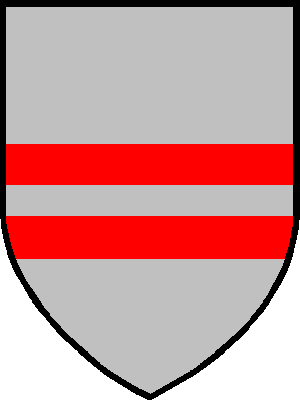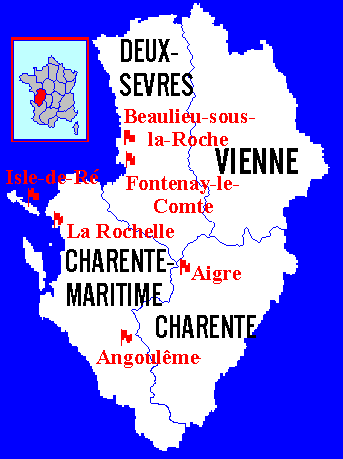![]()

|
of Madawaska |

|
![]()
Barnabé Martin presents historical problems for genealogists attempting to trace his origins in Acadia. Simply put, there are no records indicating who his parents are and where he came from. In fact, the first mention of Barnabé Martin is in the 1671 census of Port Royal, which lists him as being 35 years old and having a wife and two children, one 4 years old and a second 8 months old.
Although it has yet to be conclusively confirmed, it is believed that Barnabé, was married at Port Royal some time in 1666, to Jeanne Pelletret, the daugher of Simon Pelletret and Perrine Bourque. In the 1671 Acadian census, the family had "3 cattle & 2 sheep..., and by the 1678 census, they owned six acres of land and four cattle. Barnabé died between 1678 and 1686, leaving seven children. Barnabé's son René was born some time in March of 1671. He was married just before the census of 1693, to Marie Mignier dit Lagace, the widow of Joseph Gravois. Marie was the daughter of André Mignier and Jaquette Michel, and she is listed as a servant in the household of the Seigneur of Beaubassin in the 1686 census. Her father had served in the Carignan-Salières Regiment and had moved briefly from Quebec to Acadia before returning to Riviere Ouelle by 1693. René, like his great-uncle Pierre Martin, kept an orchard (in fact, when Pierre planted his apple trees from Normandy at Belleisle in 1633, near the site of modern Granville, Nova Scotia, it was the first planting of apples in North America). According to 1698 Port Royal census, in addition to his 13 arpents of land, 18 cattle, 8 hogs, 4 sheep and two gunds, René owned 50 fruit trees, the majority apple trees. By the 1707 census, they had 13 arpents of land, 11 cattle, 17 sheep, 13 hogs, and 2 guns. René and Marie's fifth son was Jean-Baptiste, who was born at Port Royal on March 15, 1704. Jean-Baptiste was married on November 24, 1732, to Marie Brun, the daughter of Claude Brun and Cécile Dugas. Jean-Baptiste and Marie had fourteen children.
In the early 1700's, the tensions between the "French Neutrals" and the English were rising daily, and finally -- on September 5, 1755, under the order of Lieutenant Governor Lawrence, the British Governor of Acadia -- the expulsion of the Acadians began. With the beginning of Le Grand Derangement, the Martin family would be scattered across North America, with some of Jean-Baptiste's family settling on the St. John River, and others seeking shelter in the Quebecois colonies along the St. Lawrence. Jean-Baptiste's sister Brigitte and other members of the Martin family actually spent time exiled in England, among other places. Jean-Baptiste's father, René, fled to Isle St. Jean (Prince Edward Island) where he died within the year at Port LaJoie. Jean-Baptiste and his wife were in Ecopaug (now Kingsclear, New Brunswick) before 1755, at which time the British conviscated their possessions and land. We also know that two of Jean-Baptiste's sons, Joseph and Amand, were at the Acadian colony on the St. John River by 1768, since they had a double wedding at Ecopaug on June 29th of that year, to Marie-Josèphe and Agathe Lejeune dit Briard respectively, both daughters of Eustache Lejeune and Marie-Anne Barrieu. Another son, François (and at least two of his brothers - Simon and Jean), were in Kamouraska by 1774, when François married Marie Euphrosine Guerette Dumont, the daughter of Michel Dumont and Rose Levasseur. In the same town three years later, in 1777, his brother Simon married Marie Genevieve Bourgoin. However, this family was clearly in Ecopaug as well, because their daughter Suzanne was born there before 1783, and their son Raphael was born in St. Basile, Madawaska in 1794 -- so they traveled up the St. John with the rest of the Acadian exiles after 1785.
Sainte-Anne des Pays-Bas (modern day Fredericton, New Brunswick) had been the scene of one of the only major victories by the Acadians against the British. The only Deportation ship ever captured by the Acadians, the Pembroke, and its settlers fled to the St. John River community in New Brunswick, under the protection of Boishébert. The Acadians cleared land and settled down, hoping to have their land grants approved by the British government after the war with France was over. François Martin was there as well. He reported in the 1783 census of Fredericton that he had been living there for 15 years. According to Prudent L. Mercure's Histoire du Madawaska, Twenty-eight years after the exile of 1755, Daniel Gaudin was living at Sainte-Anne des Pays-Bas with his wife, Marie-Luce Martin, and nine their children. He had been there with his wife for fourteen years, that is to say since 1769, fourteen years after the great disturbance [Grand Derangement] and twelve years after the massacre of Ste-Anne by Moncton and his Rangers one night in January 1759. The Martins, Joseph and Francis [François] had been there since 1758, i.e. 25 years. These brothers had served the British empire at the time of the American Rebellion [Revolution]... François listed his occupation was "express carrier" -- essentially he carried the mail and protected all lines of communication between Quebec and Halifax. This would explain his marriage in Quebec, while residing in New Brunswick. It also meant that he would have been quite familiar with the waters of the upper St. John River, and the fertile valley on either side, since this was the main travel route between the two British colonies. This knowledge would prove critical two years later, when English Loyalists, fleeing the United States in the aftermath of the American Revolution, would forcibly evict the Acadians from their new homes. François would sign a number of petitions sent to the officials of Quebec and New Brunswick asking for redress, to no avail. Once again, the Acadians were on the move. Determined to live free of further English interference, the families traveled up the St. John Valley, beyond Grand Falls -- where the British ships could not follow -- to the area called "the Madawaska", the Native American word for "the Land of the Porcupine..." They settled in June, 1785, on the banks of the St. John River. The Acadians has finally found a new home. By 1790, the British would finally affirm the land claims for the Acadian families on the banks of the St. John. By the time of the 1831 Maine survey, François' [I] son François [II] was living on the north side of the river, near the Parish property of St. Basil, reporting that "his father began on the lot; house, barn, 50 acres cleared... He married Scholastique Levasseur. As Deane and Kavanagh would report while surveying the area, "Almost all of [the Madawaska settlers] tan their own leather, make their own shoe-packs and Canada boots, and make also their implements of husbandry... The females manufacture the wool and flax of the raw material, until it is made into garments to wear, or other articles for domestic use. They also manufacture large quantities of Sugar from the rock-maple. Many hunt in autumn. The men appear to live easy and work only a portion of the time, which must be attributed to the productiveness of the soil. The women appear in all the houses to be spinning, weaving, preparing the cloth, and making it up for use..." François' [II] son François [III] married Marie-Luce Cyr. Their daughter, Julie Martin married Eusebe Michaud. | |||||||||||||||
![]()
|
I am still searching for information on these families,
so please
contact me
if you have anything to share!
![]()
HOME
|
Writing Resource Page
|
Genealogy Page
|
INDEX
|
|
![]()
|
|||
| |||


